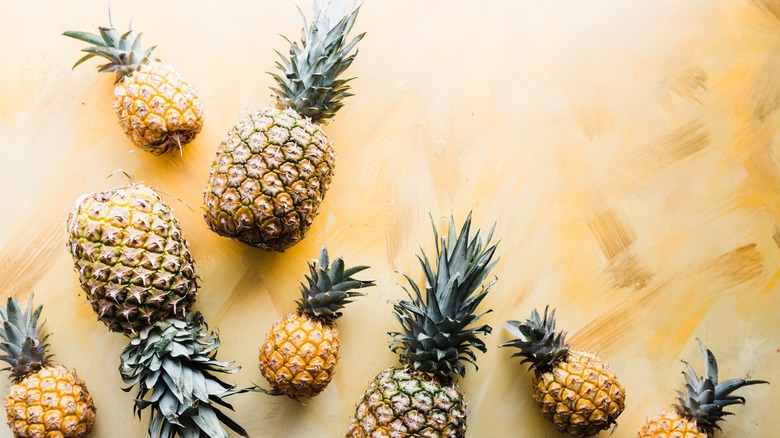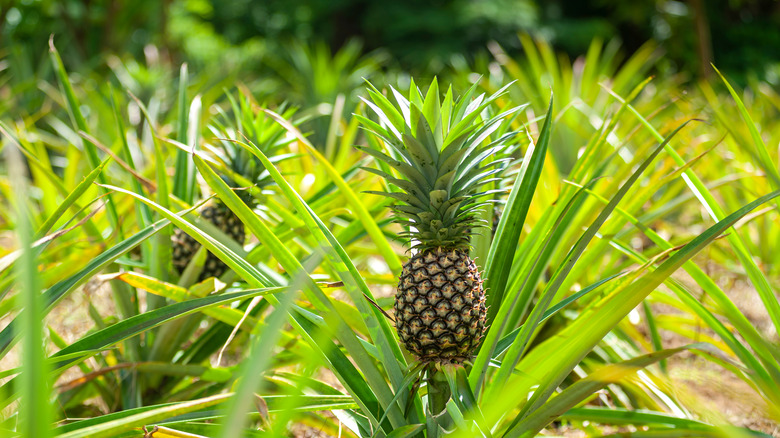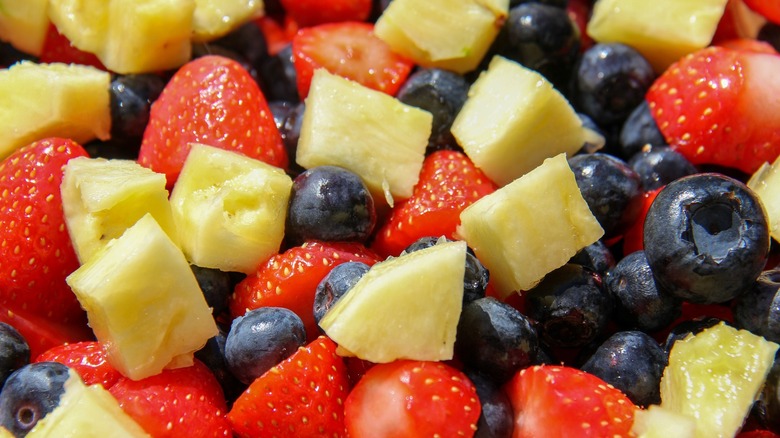Pineapples Don't Actually Grow On Trees
Unless you live in a part of the world where pineapples come from, you might not know exactly how the spiky sweet fruit is grown. Costa Rica, Brazil, and the Philippines export most of the world's pineapples and the crop contributes millions to their gross domestic product (GDP) (per Statista). These countries know a lot about how the fruit is grown.
Per History Hustle, the word for pineapple in most languages is "ananas," or a similar variant, so why do we call them pineapples? The etymology has a long history beginning with early European explorers. After being introduced to the fruit during early exploration in the Caribbean, the English named the sweet and thorny food pineapple because of its similar appearance to a pinecone and its sweet flavor like an apple (via Dole).
Pineapple's word origin is just as unusual as how the fruit is grown. Unlike most large fruits, pineapples don't grow on trees. Keep reading to find out exactly how they're grown — it may surprise you.
You can grow your own pineapple
No matter how hard you look, you won't find pineapple trees or seeds. Pineapples are grown from other pineapples which are planted in the ground. The spiky part of the fruit is known as the crown, and when a healthy plant starts to produce, a baby pineapple emerges from the center.
Christopher Columbus first found the fruit on the island of Guadeloupe, where it was cultivated by the indigenous people (via Ke Ola Magazine). Columbus brought it back to Spain, where the fruit became a status symbol prized for its sweetness and rarity. After discovering the fruit for themselves, the English tried in vain to cultivate pineapples. Unfortunately, they quickly realized it couldn't be done in England's cloudy and cool climate (via History UK).
Want to grow pineapple plants? Don't be discouraged by the failed attempts of the Brits. Masterclass explains how easy it is no matter where you live. First, remove and trim the crown, place the bottom in water, and plant it in a container with potting soil after roots form. You can keep the plant outdoors if you live in a very warm climate. Otherwise, move it indoors during cold weather.
Pick up a pineapple
There are several other edible plants that grow in unusual ways you may not be aware of. Capers are the buds of the caper bush, cinnamon comes from the bark of a tree, and asparagus grows straight out of the ground, looking somewhat like an April Fool's prank. Many nuts like cashews, almonds, and pistachios are the plant's seeds, while peanuts, perhaps surprisingly, grow underground (per Fine Dining Lovers).
No matter how strange the growing process of pineapples is, there is no denying its fresh and unique flavor, and most importantly, its versatility. Whether you're making a delicious pineapple upside-down cake, enjoying a boozy cocktail like this Pineapple, Bourbon, and Ginger Chiller, or going healthy with a fresh fruit salad, make sure you save the crown to plant. Your friends will be as surprised as you were to learn how their favorite spiky fruit is grown.


